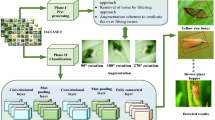Abstract
The recent survey shows at least 1 in 8 people suffer from either malnutrition or hunger. The world’s growing population is raising more concerns about increasing food productivity. Harmful pests destroy a large percentage of the food grains during the initial stage of grains growth. The qualitative productivity of food increases as measure to control increases. Also, crop yield significantly increases when complete pest management measures, such as crop rotation, biological treatments, and targeted pesticide application, are used in agriculture. The proposed methodology mainly focuses on identifying and classifying harmful and beneficial pests to increase food productivity. The correct identification of harmful pests aids in the early information to the farmers, thereby increasing grain productivity. This paper proposes a Features Pyramid Dilation Residual Convolution neural network (FDPRC net) for identifying and classifying pests in the tomato pest, Wang, Xie, and pest dataset. The three concrete deep learning approaches include without skip, dense skip, and residual skip connection architectures. FDPRC net consists of the feature of a dilation pyramid convolution block (FDPCB). The element-wise addition of feature representations from each FDPCB’s increases the representational capability of the FDPRC net. The dilated convolution blocks increase the field of view without increasing the parameters. The residual and dense skip connections have mainly reduced the vanishing gradient problem in the proposed deep neural network. Multiple training and test sets using various data sets have shown that the proposed FDPRC net performs better than the state-of-the-art techniques. The residual skip connection with FDPRC net achieved greater classification and identification accuracy of 98.12%, 97.43%, 93.98%, and 93.46% for the tomato pest, wang dataset, Xie dataset and pest dataset respectively.
Similar content being viewed by others
Data availability
Data will be made available on reasonable request.
References
Wu, X., Zhan, C., Lai, Y.-K., Cheng, M.-M., Yang, J.: Ip102: A large-scale benchmark dataset for insect pest recognition. In: 2019 IEEE/CVF Conference on Computer Vision and Pattern Recognition (CVPR), pp. 8779–8788 (2019). https://doi.org/10.1109/CVPR.2019.00899
Nanni, L., Maguolo, G., Pancino, F.: Insect pest image detection and recognition based on bio-inspired methods. Eco. Inform. 57, 101089 (2020). https://doi.org/10.1016/j.ecoinf.2020.101089
Kasinathan T, Singaraju D, Srinivasulu Reddy U. Insect classification and detection in field crops using modern machine learning techniques. Inf. Process. Agric. 8(3), 446–457 (2021) https://doi.org/10.1016/j.inpa.2020.09.006
Zhang, Y., Liu, Y.: Identification of navel orange diseases and pests based on the fusion of densenet and self-attention mechanism. Comput. Intell. Neurosci. 2021, 1–12 (2021). https://doi.org/10.1155/2021/5436729
Li, W., Zheng, T., Yang, Z., Li, M.: Classification and detection of insects from field images using deep learning for smart pest management: a systematic review. Ecol. Inform. 66, 101460 (2021). https://doi.org/10.1016/j.ecoinf.2021.101460
Wang, J., Lin, C., Ji, L., Liang, A.: A new automatic identification system of insect images at the order level. Knowl.-Based Syst. 33, 102–110 (2012). https://doi.org/10.1016/j.knosys.2012.03.014
Malek, M.A., Reya, S.S., Hasan, M.Z., Hossain, S.: A crop pest classification model using deep learning techniques. In: 2021 2nd International Conference on Robotics, Electrical and Signal Processing Techniques (ICREST), pp. 367–371 (2021). https://doi.org/10.1109/ICREST51555.2021.9331154
Xie, C., Zhang, J., Li, R., Li, J., Hong, P., Xia, J., Chen, P.: Automatic classification for field crop insects via multiple-task sparse representation and multiple-kernel learning. Comput. Electron. Agric. 119, 123–132 (2015). https://doi.org/10.1016/j.compag.2015.10.015
Cheng, X., Zhang, Y., Chen, Y., Wu, Y., Yue, Y.: Pest identification via deep residual learning in complex background. Comput. Electron. Agric. 141, 351–356 (2017). https://doi.org/10.1016/j.compag.2017.08.005
Cheng, X., Zhang, Y., Chen, Y., Wu, Y., Yue, Y.: Pest identification via deep residual learning in complex background. Comput. Electron. Agric. 141, 351–356 (2017). https://doi.org/10.1016/j.compag.2017.08.005
Wang, X., Liu, J., Zhu, X.: Early real-time detection algorithm of tomato diseases and pests in the natural environment. Plant Methods 17, 43 (2021). https://doi.org/10.1186/s13007-021-00745-2
Peng, H., Xu, H., Gao, Z., Zhou, Z., Tian, X., Deng, Q., He, H., Xian, C.: Crop pest image classification based on improved densely connected convolutional network. Front. Plant Sci. 14, 1133060 (2023). https://doi.org/10.3389/fpls.2023.1133060
Chithambarathanu, M., Jeyakumar, M.K.: Survey on crop pest detection using deep learning and machine learning approaches. Multimedia Tools Appl. (2023). https://doi.org/10.1007/s11042-023-15221-3
Amin, J., Anjum, M.A., Zahra, R., Sharif, M.I., Kadry, S., Sevcik, L.: Pest localization using yolov5 and classification based on quantum convolutional network. Agriculture 13(3), 662 (2023). https://doi.org/10.3390/agriculture13030662
Amaranageswarao, G., Deivalakshmi, S., Ko, S.-B.: Deep dilated and densely connected parallel convolutional groups for compression artifacts reduction. Digital Signal Process. 106, 102804 (2020). https://doi.org/10.1016/j.dsp.2020.102804
Wang, W., Liu, Q., Wang, W.: Pyramid-dilated deep convolutional neural network for crowd counting. Appl. Intell. 52, 1825–1837 (2022). https://doi.org/10.1007/s10489-021-02537-6
He, K., Zhang, X., Ren, S., Sun, J.: Deep residual learning for image recognition 7 (2015)
Hu, J., Shen, L., Sun, G.: Squeeze-and-excitation networks. In: 2018 IEEE/CVF Conference on Computer Vision and Pattern Recognition, pp. 7132–7141 (2018). https://doi.org/10.1109/CVPR.2018.00745
Huang, M.-L., Chuang, T.C.: A database of eight common tomato pest images. Mendeley Data (2020). https://data.mendeley.com/datasets/s62zm6djd2/1
Dataset. https://bit.ly/3mY5kU5. Accessed on: [Insert Date]
Author information
Authors and Affiliations
Contributions
MR and PP supervised the research. NV mostly conducted experiments, collected and analysed data, and produced the main manuscript; All of the authors discussed the results, provided assistance, and revised their manuscripts.
Corresponding author
Ethics declarations
Conflict of interest
The authors declare that they have no conflict of interest.
Additional information
Publisher's Note
Springer Nature remains neutral with regard to jurisdictional claims in published maps and institutional affiliations.
Supplementary Information
Below is the link to the electronic supplementary material.
Rights and permissions
Springer Nature or its licensor (e.g. a society or other partner) holds exclusive rights to this article under a publishing agreement with the author(s) or other rightsholder(s); author self-archiving of the accepted manuscript version of this article is solely governed by the terms of such publishing agreement and applicable law.
About this article
Cite this article
Vedhamuru, N., Malmathanraj, R. & Palanisamy, P. Features of pyramid dilation rate with residual connected convolution neural network for pest classification. SIViP 18, 715–722 (2024). https://doi.org/10.1007/s11760-023-02712-x
Received:
Revised:
Accepted:
Published:
Issue Date:
DOI: https://doi.org/10.1007/s11760-023-02712-x




